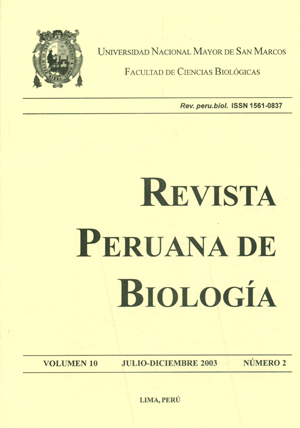Limnological characteristics of the Amazonic Cashibococha Lake (UcayaliPeru) at 2001
DOI:
https://doi.org/10.15381/rpb.v10i2.2501Keywords:
Cashibococha, Ucayali, Amazonian lakes, plankton, Amazonian fishesAbstract
Cashibococha lagoon was studied during 2001 year. Three stations were bimonthly sampling. Cashibococha have greenish to brownish colour water, pH between 6 to 6,8, Conductivity 10 to 30 µS.cm-1 , Transparency 21 to 59 cm and Total Alkalinity 14 to 22 mg CaCO3 / L. Surface temperature were between 24,4 and 37° C and Dissolved Oxygen 1,3 and 7,4 mg / L. Bacteriological analysis report 350 to 3600 CFU / mL for mesophilic aerobic bacteria and 3 to 43 NMP / 100 mL for total Coliforms. A total of 47 species of Freshwater Macrophytes were recorded and mayor diversity was associated with inundation of the forest period (octubre − noviembre). A total of 52 phytoplankton species were found, Chlorophyta Division was the dominant and Actinastrum hantzschi, Spirogyra sp., Eudorina elegans, Pandorina morum y Closterium kuetzingui were the principal species. In zooplankton community was recorded 54 species and the taxa dominant was Rotifera with Brachionus patulus macracanthus and Polyarthra vulgaris as principal species. Characiforms fishes was dominant and Curimata vittata the principal specie. Shannon-Wiener diversity index were highest to 3,0 bits. ind-1 in all places and times of sampling.Downloads
Downloads
Published
Issue
Section
License
Copyright (c) 2003 José Riofrío, Iris Samanez, Fredi Carrasco, Mirella Clavo

This work is licensed under a Creative Commons Attribution-NonCommercial-ShareAlike 4.0 International License.
AUTHORS RETAIN THEIR RIGHTS:
a. Authors retain their trade mark rights and patent, and also on any process or procedure described in the article.
b. Authors retain their right to share, copy, distribute, perform and publicly communicate their article (eg, to place their article in an institutional repository or publish it in a book), with an acknowledgment of its initial publication in the Revista Peruana de Biologia.
c. Authors retain theirs right to make a subsequent publication of their work, to use the article or any part thereof (eg a compilation of his papers, lecture notes, thesis, or a book), always indicating its initial publication in the Revista Peruana de Biologia (the originator of the work, journal, volume, number and date).


















